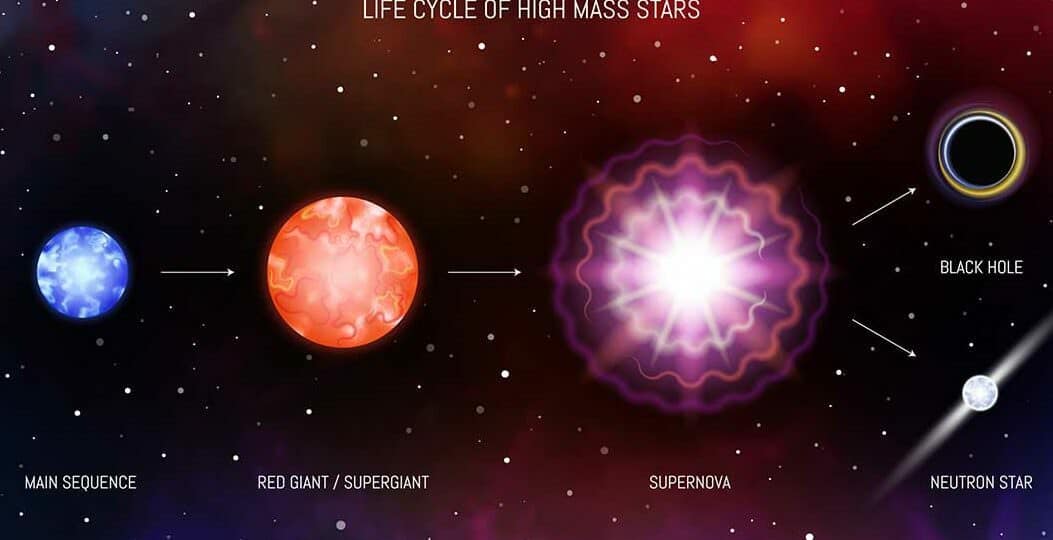When a star completes its life cycle, it undergoes a cataclysmic explosion known as a supernova. What leads to this occurrence and what are the implications of such events?
advertisement
Similar to living organisms, stars possess a life cycle that culminates in their demise. However, unlike humans and animals, stars frequently conclude their life cycle with an explosive event referred to as a supernova eruption.
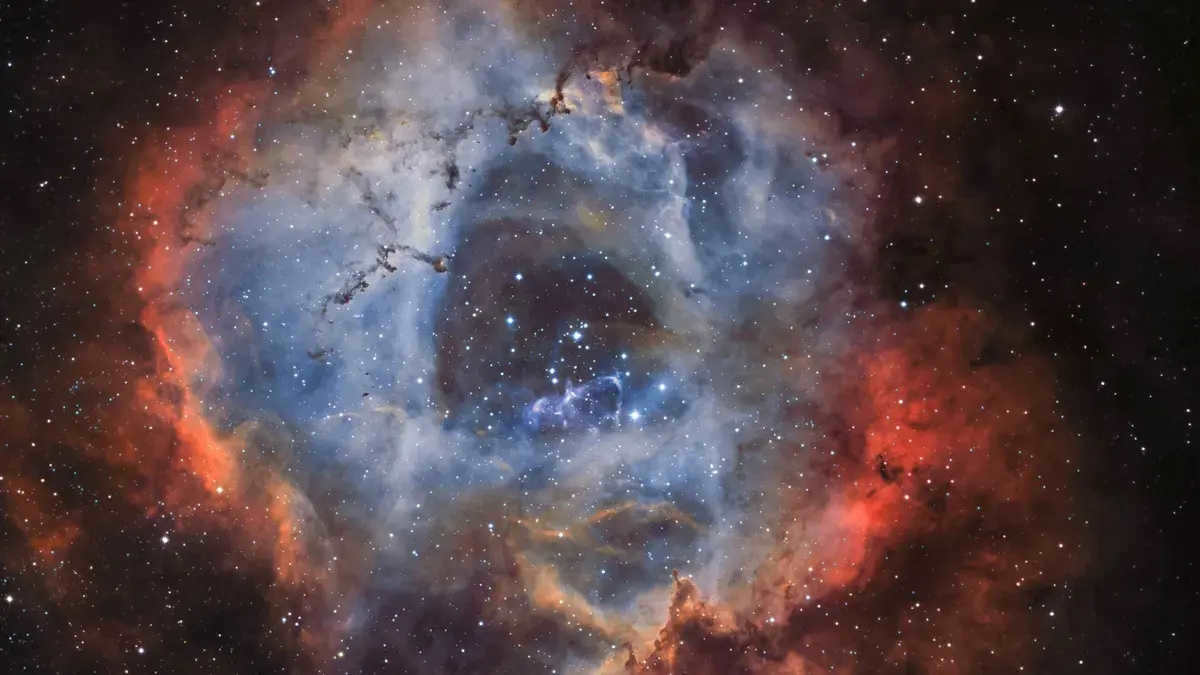
When a star completes its life cycle, it undergoes a tremendous explosion, resulting in the formation of a supernova. What is the process behind this phenomenon and what are its implications? The Rosetta Nebula located in the Unicorn constellation. Soubrette/iStock. Journal Interesting Engineering.
advertisement
Scientists hypothesize that supernovae play a vital role in the creation of elements beyond iron on the periodic table. When a supernova explodes, it releases particles containing these heavier elements into the vast expanse of space. Some of these particles eventually find their way to Earth. In the following sections, we will provide an overview of supernovae, including their various types, formation processes, and the profound impact they have on our ever-expanding Universe.
What does the term “supernova” mean?
In simple terms, a supernova refers to a powerful explosion that takes place during the final stages of a massive star’s evolution, or when a smaller white dwarf star undergoes an irreversible process of thermonuclear fusion.
Supernovae are the most colossal events witnessed in the universe. They possess both destructive and creative qualities, serving as the primary origin of heavy elements throughout the cosmos. In galaxies the size of our Milky Way, supernova explosions take place approximately once every 50 years.
Categories of supernovae
Promotion
Supernovae can be divided into two primary categories, Type I and Type II, depending on the manner in which they explode. Type I supernovae can be further classified into three subgroups – Ia, Ib, and Ic – based on their spectra.
AIM-260: The missiles developed by the United States have the ability to perform hit-to-kill kinetic strikes against targets in Russia and China
A Type II supernova is a type of supernova that occurs when the core of a massive star collapses. This phenomenon happens during the final stage of the star’s life. Massive stars that end as Type II supernovae are known for their immense mass, typically ranging from eight to fifteen times the mass of our Sun. When these stars deplete their fuel, starting with hydrogen and then helium, they still possess enough energy and pressure to create carbon.
Over time, heavier elements begin to accumulate in the core. When the core’s mass exceeds the Chandrasekhar limit, which is the maximum mass a stable white dwarf can have (approximately 1.44 solar masses), implosion occurs. Eventually, the implosion rebounds off the core, resulting in the ejection of stellar material into space – this is the outburst of the supernova. This process leaves behind a highly dense neutron star.
There exist two distinct subcategories of Type II supernovae, characterized by variations in their brightness throughout their lifespan. The luminosity of a Type II-Liner supernova diminishes swiftly and consistently after a pronounced peak, whereas Type II-Plateau supernovae continue to radiate with considerable intensity for extended durations. Both of these classifications exhibit a hydrogen signature in their spectral composition.
Type I supernovae
advertisement
Type I supernovae can be classified into three subtypes: Ia, Ib, and Ic. What sets them apart from other supernovae is the absence of a hydrogen line in their light spectrum.
Subtype Ia: This subtype is believed to occur in binary star systems that consist of a moderately massive star and a white dwarf. In these systems, matter from the larger companion star flows onto the white dwarf. Once the white dwarf accumulates enough mass to surpass the Chandrasekhar limit, it undergoes a powerful explosion. Type Ia supernovae are quite common and have a consistent peak luminosity, making them valuable tools for astrophysicists to gauge cosmic distances.
Subtype Ib: Similar to type II supernovae, these supernovae also undergo core collapse, but without the presence of hydrogen. As a result, they are classified as type I. Additionally, they exhibit helium lines in their spectra.
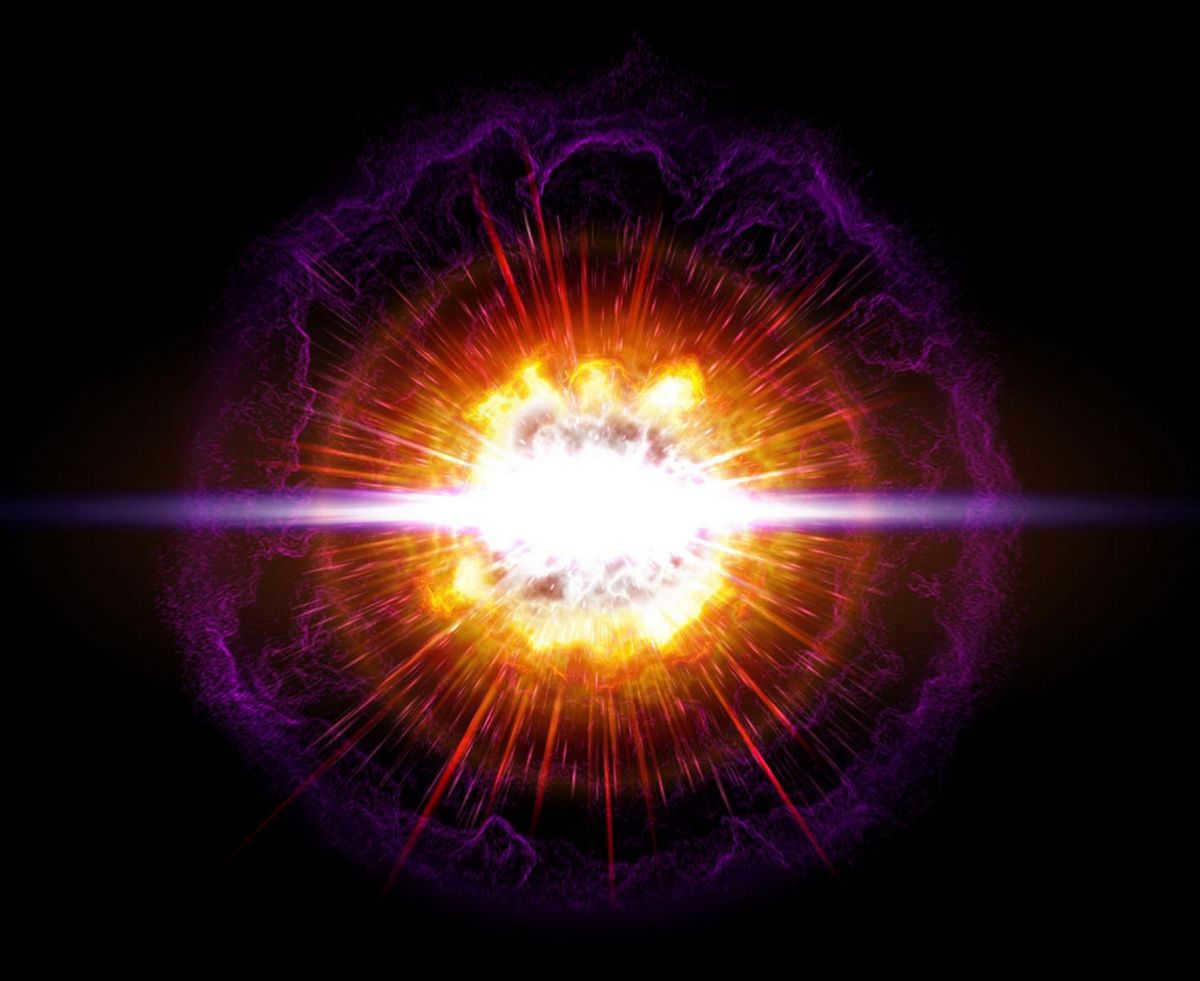
Studying supernovae has provided us with knowledge about the evolution of stars and the various stages they undergo before their explosion. Extensive research has led scientists to recognize the significant role that supernovae play in the creation of new stars, planets, and other celestial bodies in our vast universe. The image captures the moment of a celestial sphere undergoing a powerful explosion. Soubrette. Journal Interesting Engineering.
Subtype Ic: This specific category of supernovae is also generated when a massive star collapses due to its own gravitational force. Type Ic supernovae typically lack hydrogen and helium in their spectrums, as these elements have been “lost” throughout the star’s lifespan.
In addition to these types of supernovae, there exist various other subcategories within Type I and II supernovae, such as Type Ic – BL supernovae, which are associated with gamma-ray bursts and extremely luminous supernovae.
The life cycle of a star concludes with the formation of a supernova.
Similar to living beings, stars experience various stages in their life cycle, starting from their formation and concluding with their demise. Nevertheless, in contrast to living organisms, stars have an exceptionally long lifespan that can span billions of years. Prior to a supernova eruption, a star must successfully navigate through several distinct phases. Let us examine the different stages of stellar evolution outlined below.
Stellar nebula
The process of star formation takes place within a stellar nebula, which is a celestial cloud composed of dust and various gases, such as hydrogen and helium. Due to this characteristic, certain nebulae have been referred to as “nurseries” for stars. Nebulae themselves are created from the ejection of gas and dust during the explosive demise of a star, such as during a supernova event.
Within nebulae, gas and dust particles are dispersed in a scattered manner initially, but as time progresses, they start to aggregate due to the impact of gravitational forces. As these aggregations grow, their gravitational pull also strengthens, drawing in an increasing number of particles. Eventually, the density of the dust and gas fragment reaches a point where it collapses under its own gravitational force. This collapse results in the heating up of the material and the formation of a protostar.
Protostar
The subsequent stage or phase in the life cycle of a star involves the creation of a protostar. During this stage, there is a further condensation of the gas and dust present in the nebula. As the material becomes denser, the temperature and pressure in the core gradually increase, eventually leading to the initiation of nuclear fusion.
The protostar bears a resemblance to a typical star, but its core has not yet reached the necessary temperature for fusion to commence. The luminosity of a protostar is determined by the heating and compression of its core. The period of gravitational contraction is relatively brief and varies depending on the mass of the protostar. Higher-mass protostars undergo a more rapid process of gravitational condensation. Protostars with a mass equivalent to that of our Sun will shrink within a time frame of 100 million years.
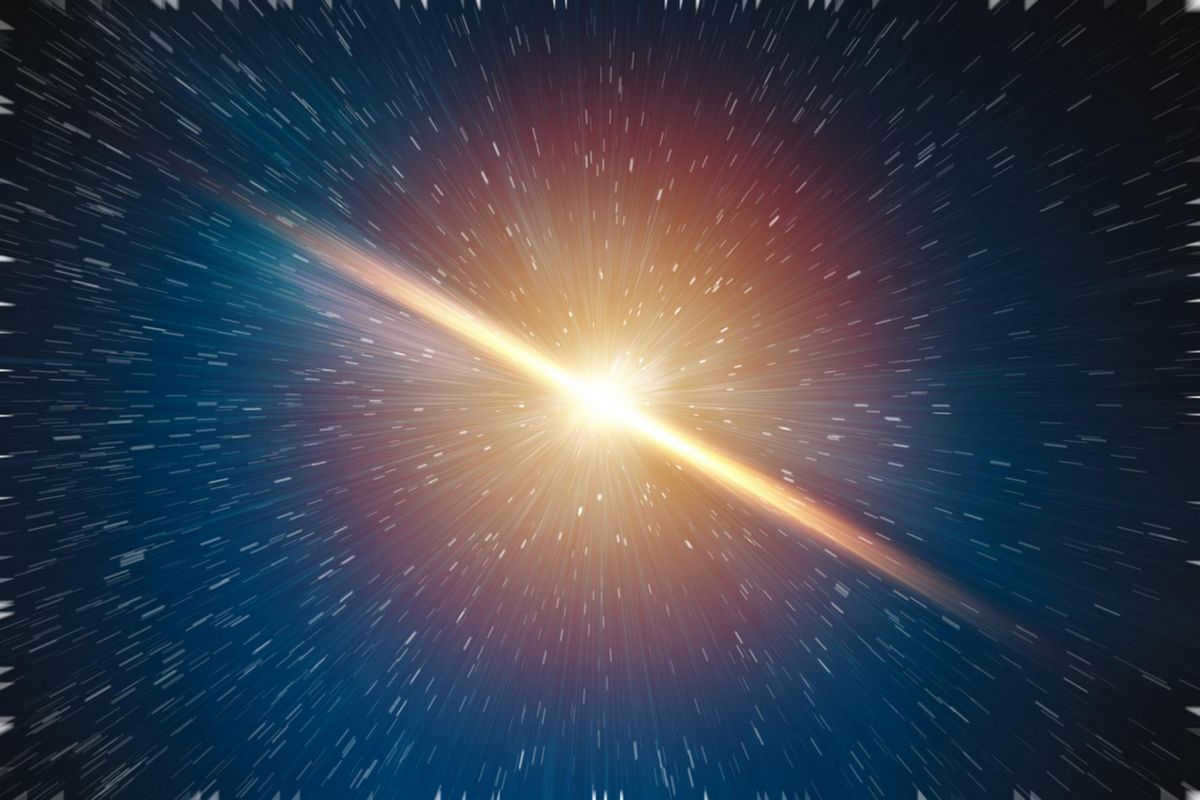
During the explosion of supernovae, essential elements such as iron, potassium, neon, and others are expelled into space, eventually becoming the building blocks for the creation of new stars. This process sets the stage for the cycle to begin anew. Some of these expelled elements may eventually come together to form planets, including our very own Earth. The image showcases the brilliant burst of light from a supernova star. coffeekai/iStock. Journal Interesting Engineering.
A dust cloud forms around the youthful star, which then begins to rotate and take on a “flattened” shape, forming a proplyd or protoplanetary disk. In certain cases, these disks can evolve into complete planetary systems. The protostar phase represents the critical point at which the gas-dust cloud transforms into a fully-fledged star. This phase is vital in the formation of young stars.
Once the protostar’s core temperature surpasses 10 million K, the hydrogen fusion process achieves its utmost efficiency. At this juncture, the protostar transitions into the main-sequence phase.
Main Sequence
Throughout the main sequence, stars typically spend the majority (approximately 90 percent) of their lifetimes. The duration of this stage hinges on the star’s mass, which can vary significantly.
High-mass stars typically possess a more scorching and denser core, enabling nuclear fusion to progress at a swifter pace, resulting in a shorter main-sequence phase. Conversely, lighter stars have smaller cores, leading to a slower pace of nuclear fusion and a lengthier main-sequence stage.
Red giant star
Stars that are similar in size to our Sun or slightly smaller have the potential to transform into red giants.
Once main-sequence stars deplete their hydrogen fuel in the core, they start to contract due to the insufficient fusion energy to counteract gravity. However, the core keeps shrinking and becoming denser, causing the temperature and pressure to increase. This allows helium to undergo fusion and transform into carbon, releasing even more energy. Consequently, the outer layers of the star expand and become more luminous as hydrogen fusion progresses towards them.
57 fighter jets and nineteen ships from the Chinese Army violated the median line in the Taiwan Strait
Over time, a red giant star is formed, growing more and more unstable. Eventually, the star’s outer layers collapse, creating a cloud of dust and gas that expands. This expansion continues until it disperses into space, transforming the star into a planetary nebula. In approximately 5 billion years, our Sun will go through the red giant stage.
Planetary nebulae and white dwarfs
Let’s consider a scenario where the outer region of a red giant star has expanded into space, but it continues to orbit around a central core called a white dwarf. Consequently, there is a layer of gas and dust surrounding the dense white dwarf core. The radiation emitted by the white dwarf core ionizes the gas and dust envelope. White dwarfs can emit visible light that ranges from blue-white to red. However, white dwarfs do not produce their own heat (as they lack thermonuclear energy sources) and gradually cool off over billions of years.
Supernova
The development of stars with a mass of approximately eight times that of our Sun follows a distinct path. Once the core of such a star depletes its hydrogen fuel, it will commence a process of contraction. This will result in another collapse, triggering a thermonuclear reaction involving helium.
Subsequent events depend on the size of the star.
A main-sequence star slightly larger than the Sun will initiate the conversion of helium into carbon, similar to stars with lower masses. However, when the core exhausts its helium supply, it will contract, heat up, and proceed to convert carbon into neon, followed by oxygen, silicon, and ultimately iron. Each new “fuel” release the necessary energy to prevent the nucleus from collapsing. Nevertheless, with each successive “fuel,” the reaction accelerates compared to the previous one.
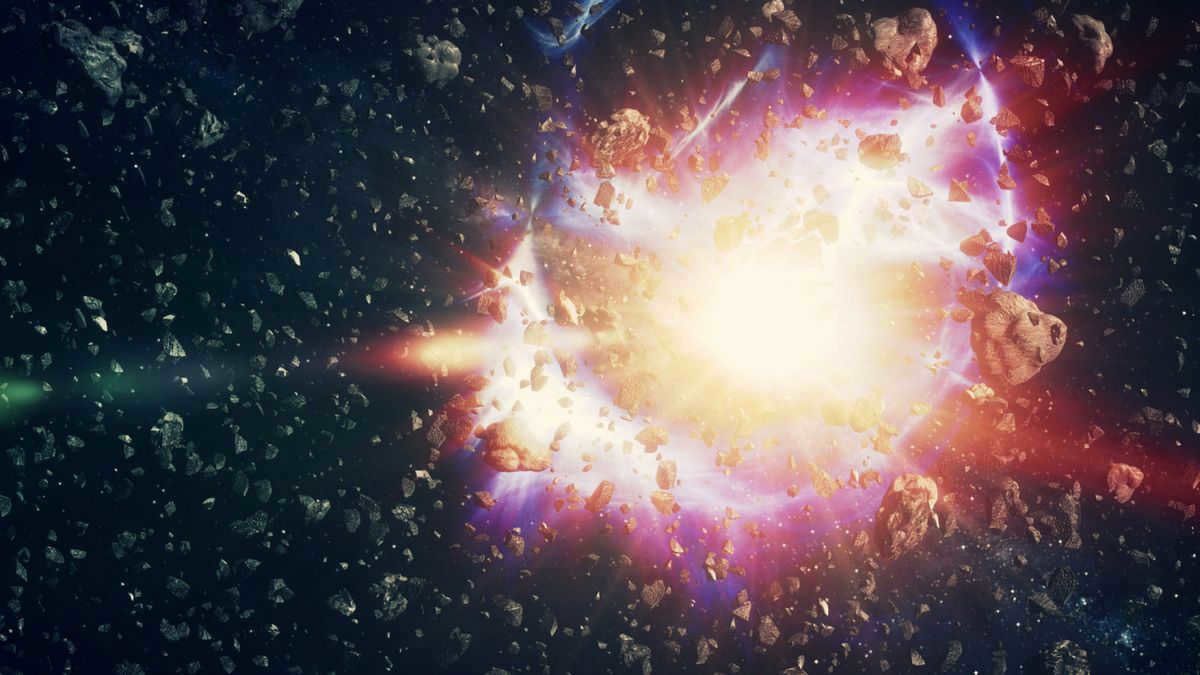
The study of supernovae has provided us with valuable insights into the evolution of stars and the different stages they go through before undergoing a powerful explosion. Stars that are similar in size to our Sun or slightly smaller have the ability to transform into red giants before becoming supernovae. This phenomenon, captured by cokadas/iStocks and featured in the Journal Interesting Engineering, is truly fascinating.
As a star reaches the point where silicon turns into iron, it is nearing the end of its fuel supply. At this stage, the core of the star collapses, rapidly returning to its original size. This collapse generates a shock wave that triggers a supernova eruption. The remaining core material forms an incredibly dense neutron star. For stars with a mass surpassing three times that of the Sun, the collapse leads to the formation of black holes.
The Influence of Supernovae on the Cosmos
Similar to all celestial bodies, supernovae eventually dwindle, but their impact on the progression of our universe is noteworthy. The study of supernovae has aided astrophysicists and astronomers in gaining a better comprehension of the ongoing expansion of our universe. Consequently, scientists have determined that a crucial consequence of a supernova’s explosion is the release of essential elements from its core.
During a supernova’s explosion, significant elements such as iron, potassium, neon, and others are emitted into space, ultimately becoming the building blocks for the creation of new stars. And so the cycle continues. Some of these released elements may eventually coalesce to form planets, such as our own Earth.
The exploration of supernovae and their significance in the field of astrophysics
By delving into the study of supernovae, we have gained insights into the evolutionary process of stars and the various stages they undergo before reaching their explosive climax. Through extensive research, scientists have come to appreciate the pivotal role that supernovae play in the birth of new stars, planets, and other celestial bodies within the vast expanse of the universe.
For astrophysicists and astronomers alike, understanding supernovae, the life cycle of stars leading up to these cataclysmic events, and the far-reaching consequences they entail, is of utmost importance. This collective knowledge serves to deepen our understanding of the chemical evolution and expansion of the Universe. Furthermore, the study of supernovae has not only shed light on the formation of heavy elements within stars, but has also provided valuable insights into the creation of black holes and neutron stars.
Exploring supernovae has not only aided in uncovering insights into the origins of heavy elements within stars, but also the formation of black holes and neutron stars. Additionally, studying the process of stellar birth serves as a means to measure the distances between galaxies.
While a supernova event may appear transient at first glance, its significance in the creation of stars and other celestial bodies cannot be overstated. Furthermore, the role of these processes in the development of life-sustaining elements cannot be understated.
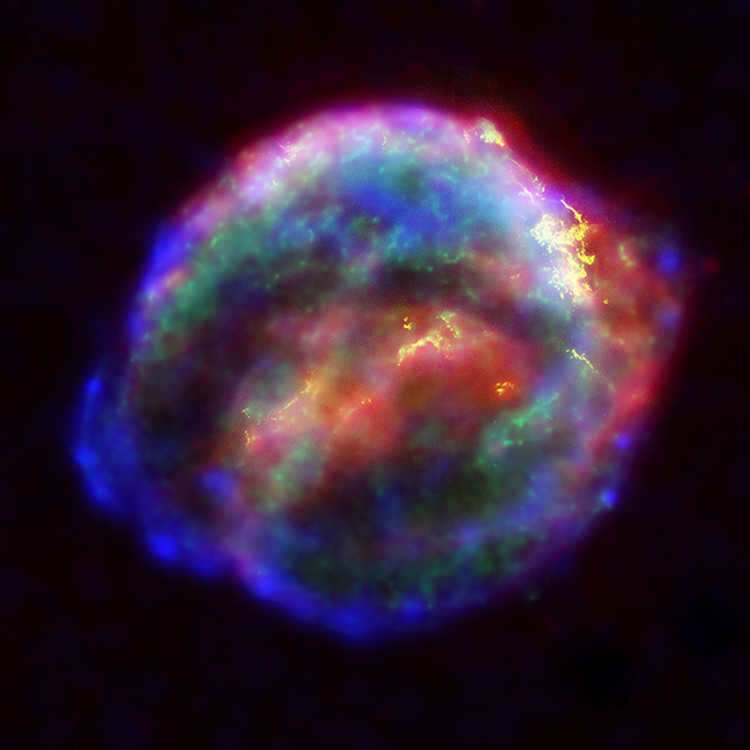
A supernova is an extraordinary celestial occurrence that happens during the final phases of the life cycle of specific kinds of massive stars. This event is marked by an immense and explosive discharge of energy, leading to a sudden and substantial surge in luminosity that can outshine an entire galaxy for a brief duration. Supernovae represent some of the most potent phenomena documented in the cosmos and have a vital role in the creation and dissemination of dense elements, including iron and gold.
Formation and classification
When a massive star burns through all of its nuclear fuel, its core collapses, resulting in a supernova. The collapse is caused by different mechanisms depending on the star’s mass. There are two main types of supernovae: Type I and Type II.
Type I supernovae
Type I supernovae can be further divided into subtypes, including Type Ia, Type Ib, and Type Ic. These supernovae occur when a white dwarf star in a binary system gains enough mass from its companion star to exceed the Chandrasekhar limit. This triggers a nuclear fusion reaction that rapidly consumes the white dwarf, causing a massive explosion.
Type II supernovae
Type II supernovae take place when massive stars, typically those with a mass eight times that of the Sun, come to the end of their lifespan. When the nuclear fuel in their cores is exhausted, the core collapses due to its own gravitational pull, resulting in a rapid implosion. The implosion is halted by the rebound force of the dense core, generating a powerful shockwave that spreads throughout the star, ultimately resulting in a massive explosion and the expulsion of the outer layers into outer space.
During a supernova event, an immense quantity of energy is discharged in the form of radiant energy, thermal energy, and high-energy particles. The luminosity of a supernova has the potential to momentarily surpass that of an entire galaxy, and its radiance can be observed over vast distances. The explosion also emits a wide array of electromagnetic radiation, including X-rays and gamma rays.
The aftermath of a supernova is equally fascinating. As a consequence of the detonation, heavy elements and other substances are propelled into outer space, enriching the interstellar medium. These expelled materials may subsequently become integrated into nascent stellar systems, planets, and even biological organisms. Supernovae also act as a significant mechanism for the dispersion of life-sustaining elements such as carbon, oxygen, and nitrogen throughout the cosmos.
Observation and study
Supernovae are carefully observed and studied by scientists in order to gain a deeper understanding of the fundamental physics of stellar evolution, the origins of heavy elements, and the dynamics of the universe. Astronomers utilize a range of telescopes and instruments to observe supernovae across various wavelengths, such as optical, X-ray, and radio waves. Through the analysis of the emitted light at different stages of supernova evolution, valuable information can be obtained regarding the progenitor star, the mechanism behind the explosion, and the surrounding environment.
Famous supernovae
Throughout history, numerous supernovae have been observed and documented. One renowned example is SN 1054, which resulted in the formation of the Crab Nebula and was recorded by ancient Chinese astronomers in 1054. Another notable supernova, known as SN 1987A, occurred in the Large Magellanic Cloud, a satellite galaxy of the Milky Way. This event has provided scientists with invaluable insights into the later stages of stellar evolution.
Supernovae are extraordinary occurrences that signify the explosive demise of massive stars. They play a crucial role in shaping the intricate fabric of our Universe. These celestial events act as powerful laboratories for studying astrophysical processes, contributing to the enrichment of the cosmos with heavy elements, and influencing the evolution of galaxies. The ongoing investigation and research of supernovae continue to enhance our understanding of the cosmos and our place within it.
Approximately a decade ago, I ventured into the world of blogging on LiveJournal as a secondary endeavor (and have since been engaging in this activity for around eighteen months). During my time there, I dabbled in various writing styles, including popular science, philosophical and religious topics. One particular subject that captivated my interest was the High Middle Ages. I delved into the works of renowned authors such as Jacques le Goff, Henri de Lubac, Norman Davies, and Johan Huizinga, continuously immersing myself in their writings. The XV-XVI centuries in European history intrigued me due to their significance as the “longest night before dawn” in Western civilization. This period witnessed the disintegration of the unified Catholic oikoumene, the rapid development of the natural-scientific worldview, influenced by Indian and Islamic foundations, and the expansion of geographical knowledge. All these advancements transpired amidst the backdrop of religious obscurantism, creating a stark contrast. The XIV-XVII centuries were marred by a series of devastating plague epidemics that claimed the lives of educated clergymen. It was the priests who found themselves at the epicenter of unsanitary and overcrowded conditions, as they administered last rites to the afflicted and kissed plague crosses. Subsequently, these positions were filled by understudies and fanatics who transformed Christian preaching into a witch hunt.
However, it was during the lifetime of the previous generation before Newton and Boyle (specifically, during the later years of Katharina Kepler) that two significant events occurred, which likely caused medieval Europeans in the second-to-last and last era to question the unchanging nature of the celestial bodies and hold out hope for the Second Coming. These events were the explosions of supernovae in 1572 (known as Brahe’s supernova) and 1604 (known as Kepler’s supernova), which had a profound impact on the progress of astronomy for centuries to follow and were not observed again until 1987. Although this topic may not fully align with the theme of Hubra, I will now proceed to discuss the seven supernovae that are reliably known to have occurred in the Earth’s skies throughout human history – and their significant role in the advancement of astronomy and astrophysics.
What is a supernova?
A supernova is a powerful and explosive event that occurs at the end of a star’s life. It is an astronomical phenomenon that releases an immense amount of energy, resulting in a bright and luminous explosion. This phenomenon is caused by the sudden collapse and subsequent explosion of a massive star. During a supernova, the star’s core collapses under the force of gravity, causing a rapid release of energy and the ejection of outer layers into space. The explosion can be so bright that it outshines an entire galaxy for a short period of time. Supernovae play a crucial role in the evolution of the universe, as they create and spread elements necessary for the formation of planets and life as we know it. Scientists study supernovae to gain a better understanding of stellar evolution and the processes that shape the universe.
When it comes to modern astronomy, a nova refers to a star that experiences a sudden and dramatic increase in brightness, followed by a gradual fading back to its original magnitude. Novas occur when the upper layers of dim white dwarfs explode, with excess matter from the larger star’s atmosphere being deposited onto the white dwarf’s surface. Therefore, a double star system is the ideal setting for a nova to form. On the other hand, a supernova is also a star that undergoes a sharp increase in brightness followed by a gradual dimming, but the flash is much more powerful compared to a nova. A supernova can increase its brightness up to 10,000 times more than a nova, emitting a flash billions of times brighter than the Sun. The peak brightness of a supernova is typically reached a few days after the explosion. In just a few months, a supernova emits an amount of electromagnetic energy comparable to what the Sun emits throughout its entire lifespan of 10 billion years. From a modern perspective, supernovae play a crucial role in the synthesis and dispersion of heavier elements, particularly metals. Hydrogen and helium are the most abundant elements in the universe and make up the majority of stars. These elements, along with a small amount of lithium, are considered primordial and existed shortly after the formation of the universe, long before the first stars were formed. All other elements, which constitute the majority of what we see around us, were formed through stellar evolution. Heavier elements are created through thermonuclear fusion, which serves as the foundation of stellar combustion.
The fusion of hydrogen nuclei results in the formation of helium nuclei, which then further fuse to create carbon. In the most massive stars, this fusion process continues through multiple stages, leading to the sequential formation of even heavier elements such as oxygen, neon, magnesium, sulfur, and silicon, ultimately culminating in the production of iron. However, the fusion process ceases at iron. This is the general composition that a massive star attains during its final phase of evolution:
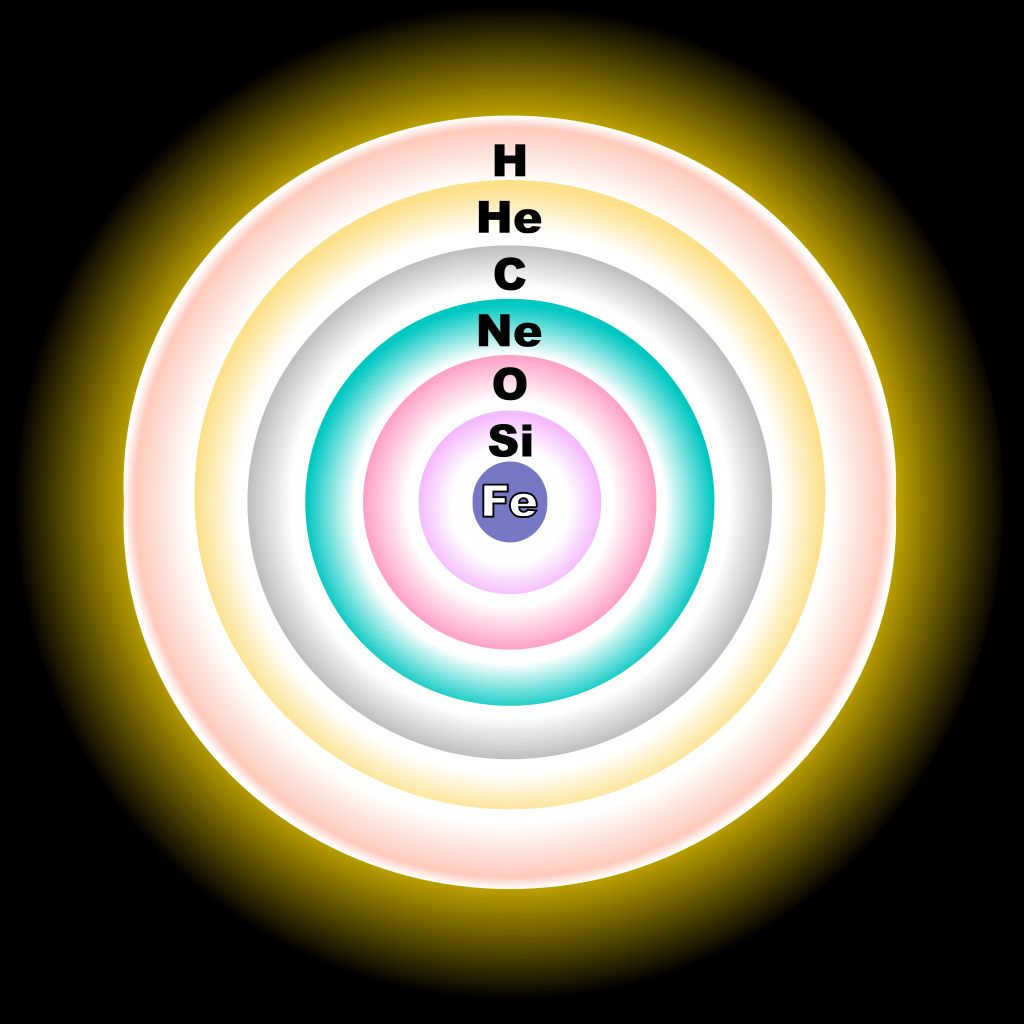
The mass of the iron core that a star can “build up” and the subsequent collapse depend on the mass of the star itself. As the core collapses, it triggers an explosion that destroys helium and heavier elements, generating a mass of free neutrons. These neutrons then combine to form elements that are much heavier than iron, including transuranic elements. As a result, the outer layers of the star are expelled in all directions, creating a luminous remnant known as a supernova. Over time, this remnant cools down and transforms into a nebula.
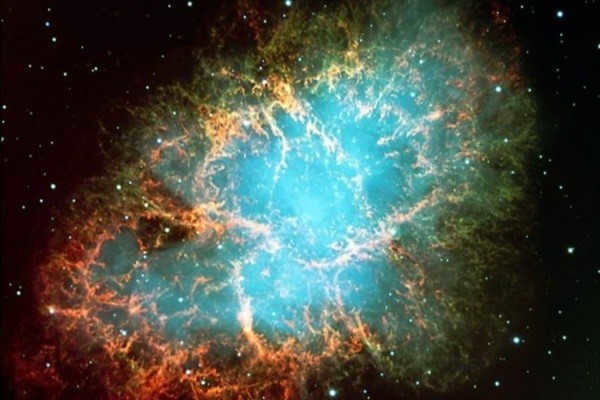
This particular nebula is called the Crab Nebula and it was created in the Taurus constellation after a supernova explosion took place on July 4, 1054. Nowadays, it can only be observed through a telescope, but back in 1054, Chinese astronomers reported that the star was visible in the sky both day and night for several weeks.
Categories of supernovae
The challenges associated with the production of elements in stars are directly connected to the Big Bang theory as it was the Big Bang that generated the initial set of chemical elements. Supernovae, on the other hand, can be seen as localized “mini-explosions”. The concepts regarding the order in which chemical elements are synthesized in stars were developed during the 1940s and 1950s. Fred Hoyle, a British astrophysicist and science fiction writer, played a role in providing theoretical support for the Big Bang theory, and Margaret and Geoffrey Burbidge, along with William Fowler, collaborated with him to explore the intricacies of stellar evolution. In 1957, they published a significant joint paper titled “Synthesis of Elements in Stars”, which laid the groundwork for the theory of explosive nucleosynthesis. It is now understood that the majority of elements in the periodic table (excluding artificially produced ones) were formed through the explosions of supernovae or the merging of neutron stars.
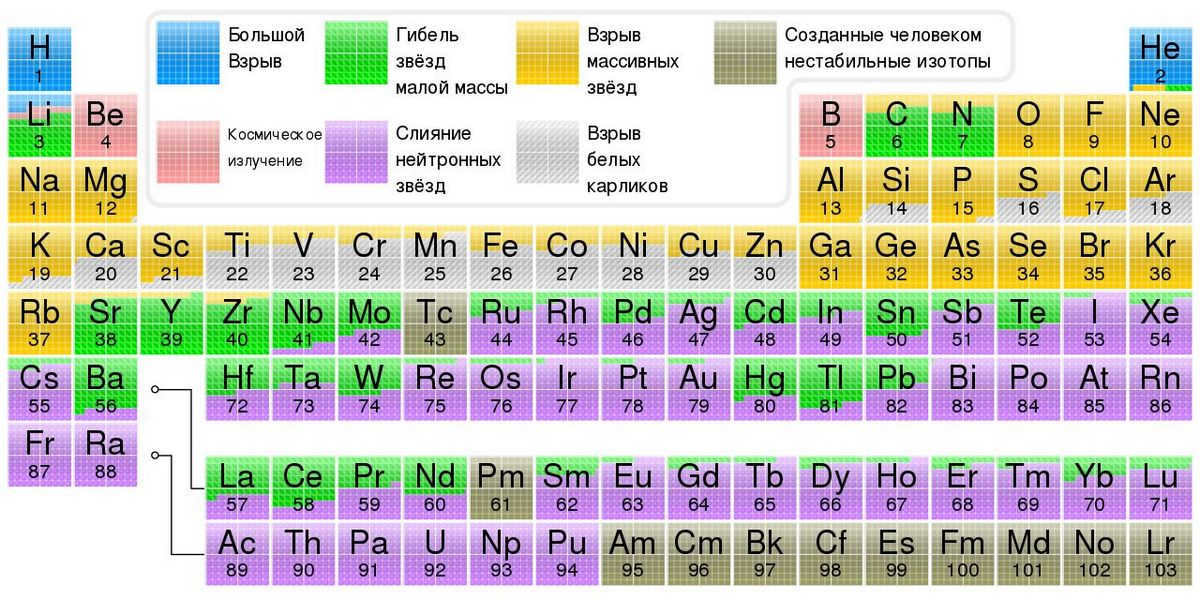
Supernova Chronology
The timeline of supernovae events has been documented by various civilizations including Arabs, Chinese, Japanese, and Europeans.
These events typically occur between approximately April 17 and May 1.
Each supernova event is visible for a period of 185 days, taking into account the darkness during which it remains visible.
Notable observers of supernovae include the Chinese, Japanese, Arabs, Europeans, and Tycho Brahe.
One significant event took place from November 2, 1572 to early 1574, with its visibility during darkness also taken into account.
Supernovae were observed by Europeans, Arabs, Johannes Kepler, and Galileo Galilei during an approximate duration of 1.5 years, considering the period of visibility in the dark.
In more recent times, South Americans, particularly those at the Las Campanas Observatory in Chile, have been able to observe supernovae events. Notably, Ian Shelton was one of the observers.
These events were observed in the Tarantula Nebula within the Large Magellanic Cloud.
Observations of supernovae continue through the end of May, but only during the dark hours.
Throughout history, astronomers have often struggled to differentiate between a new star and a comet, leading to the term “guest star” being coined. This means that it is possible that supernovae occurred in the Earth’s sky as early as 369, 437, 827, and 902. One of the most recent supernovae on record is the 1987 explosion, which could be seen without the aid of a telescope in the Andes. However, this particular supernova did not occur in our own Milky Way galaxy, but rather in the satellite galaxy known as the Large Magellanic Cloud. It is worth noting that in our own galaxy, there has not been a supernova visible to the naked eye since the eruption of Kepler’s Star in 1604. Despite this, it is the three most recent supernovae that have had the greatest impact on the field of astronomy and astrophysics. In the following sections, we will explore the specific effects that each of these supernovae has had on our understanding of the universe.
In early November 1572, a brilliant new celestial body appeared, likely visible throughout the entire northern hemisphere. This celestial body outshone all the stars in the night sky and even surpassed the brightness of Venus. Remarkably, it could be seen during daylight hours as well. At the time, the prevailing belief was in the Aristotelian model of the universe, which posited that the heavens were composed of concentric crystal spheres. The outermost sphere, known as the eighth sphere, contained the eternal and unchanging stars. According to Aristotle, both the Moon and comets resided much closer to Earth. However, Tycho Brahe contradicted this notion in his book “De Stella Nova,” wherein he cogently argued that this new star was situated much farther away than the Moon, specifically within the confines of the eighth sphere.
During the evening, after the sun had set, as was my usual practice, I found myself gazing at the stars in the clear night sky. It was then that I noticed a remarkable and unfamiliar star shining directly above me, surpassing all others in its brilliance. Having been familiar with the stars since childhood (acquiring such knowledge is quite simple), it was evident to me that this particular star had never before occupied this part of the sky, not even a faint one, let alone a star as prominently bright as this. I was so captivated by this spectacle that I couldn’t help but question the reality of what my own eyes were witnessing. However, once I confirmed that others could also see the star in the exact location I had pointed out, I had no further doubts. Wasn’t this the most extraordinary miracle to have occurred since the dawn of time.
In 1574, Brahe’s accomplishments captured the attention of the Danish authorities. Despite being a regular staff member at the University of Copenhagen, the astronomer was granted permission to deliver public lectures and instruct in mathematics. Additionally, he was bestowed with a complete castle on the island of Ven known as “Uraniborg,” where he could conduct astronomical observations and develop innovative instruments.


The star of Kepler
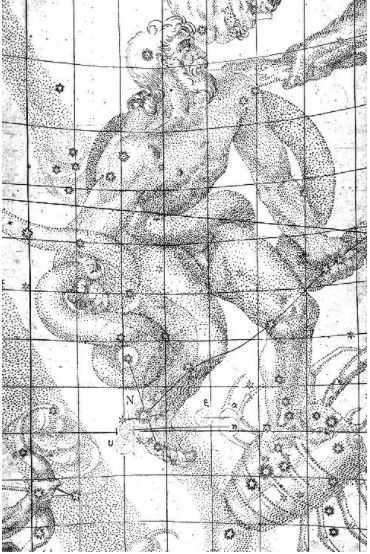
Galileo did more than just compare the coordinates of the star with observations from other parts of Europe, including the northern regions. He also pointed out that the star had originated in roughly the same area of the sky as Brahe’s star (although Galileo tried to find a pattern in this, we now know it was just a coincidence). This supernova once again highlighted the flaws in Aristotle’s cosmology and led Galileo to believe that the birth of a star has nothing to do with the convergence of three planets. Furthermore, it was after this event that Galileo began to seriously study and measure parallax; it was likely during this time that he came up with his first popular scientific explanation, comparing it to a pencil or finger.
Galileo also made an attempt to describe the characteristics of starlight by using supernovae as an illustration. He pointed out that starlight cannot be the same as ordinary fire. If the new star is much higher than the Moon, how did it come to be there? The simplest assumption was that it formed from the same material as the celestial sphere. However, during that time, it was believed that the material of the celestial spheres was unchangeable. Therefore, Galileo hypothesized that the new star originated from ordinary “terrestrial” matter that somehow rose to such a great height. Additionally, he noted that earthly fire produces a lot of smoke, whereas celestial fire does not emit any smoke (otherwise, the star would quickly disappear in its clouds). This indicates that celestial fire is of a different nature. Galileo acknowledged that some substances burn with little to no smoke, but they burn quickly, and the fire of the supernova clearly did not extinguish. Eventually, Galileo proposed that the supernova could be like a cloud of vapor with a very high reflectivity, and this cloud emits reflected sunlight similar to the Moon. Galileo found it challenging to explain how vapor from the Earth could rise to such a height, but he still likened the supernova to a distant rainbow rather than a distant bonfire.
Supernova 1987A: A Celestial Phenomenon
This unexpected supernova was both fascinating and surprising. The explosion took place in a neighboring galaxy, not in the Milky Way, at a distance of approximately 170,000 light years. As a result, the apparent brightness of the supernova was +3 (visible to individuals with keen eyesight who can distinguish stars with magnitudes up to around +6.5). Previous observations had suggested that supernovae only occur at the location of red supergiants, making this explosion at the site of the blue supergiant Sanduleak -69°202, discovered by Richard Sanduleak in 1969, particularly noteworthy. Furthermore, the explosion was accompanied by a powerful release of stellar neutrinos, which could be confidently detected. The abundance of neutrinos allowed for the development of neutrino astronomy, which has been further explored in a post on Hubra. It is worth noting that optical telescopes are not particularly effective at detecting supernovae, but the analysis of stellar neutrinos has provided us with a detailed map of these events in our own Galaxy.
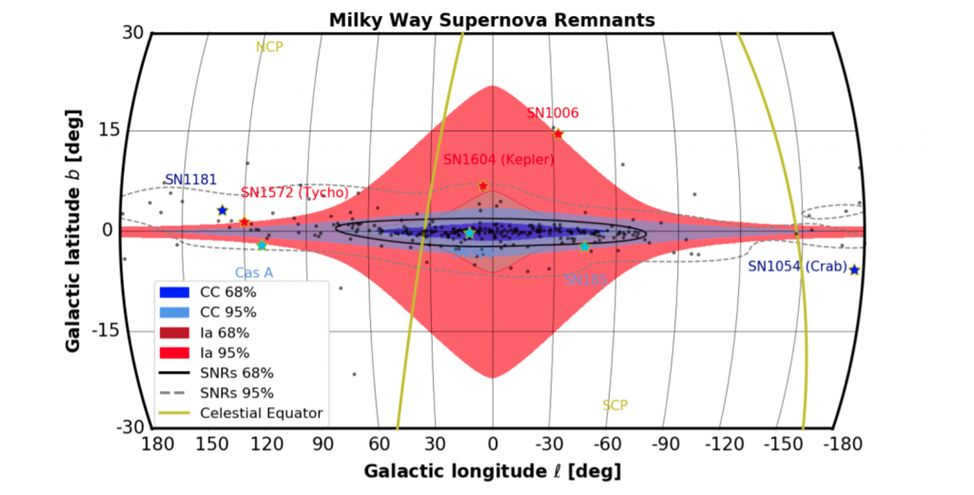
It is probable that a supernova blast creates not just a multitude of neutrinos (since we have already detected them in an explosion in a neighboring galaxy – but how would neutrino detectors respond to an explosion similar to Kepler’s star?), but also gravitational waves and maybe some exotic particles. Furthermore, analyzing the spectra of fresh supernova remnants could provide insight into the maximum atomic numbers of elements produced in these explosions – potentially even leading to the discovery of Feinmanium. In other words, the astronomical community eagerly anticipates the closest supernova not only with excitement, but also fully prepared, not overly concerned about whether the extremely close explosion of such a star will be more than astrophysics, but a true catastrophysics.
In the year 1054, an astonishing phenomenon occurred when a brilliant star unexpectedly emerged in the heavens. Its radiance was so powerful that it could even be seen during daylight hours. Chroniclers of that era meticulously documented this celestial spectacle, which was believed to be a forewarning of an impending cataclysmic event. However, contrary to these fears, no such upheaval materialized, and after gracing the sky with its luminosity for a span of 23 days, the star eventually vanished from sight. It was not until many years later that mankind came to comprehend that this extraordinary phenomenon was, in fact, a supernova.
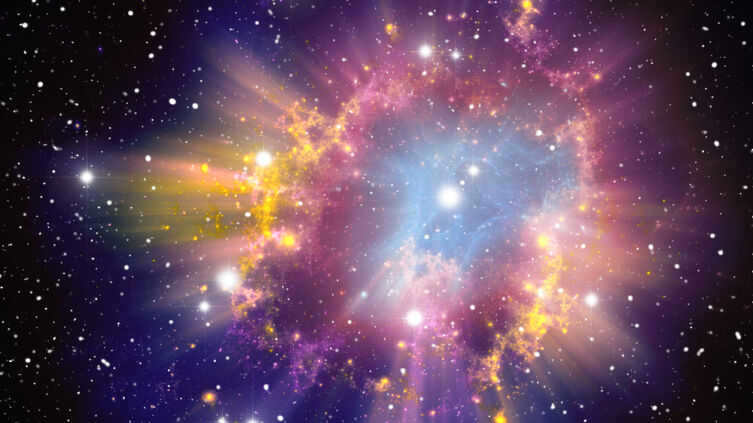
What is the frequency of supernova explosions?
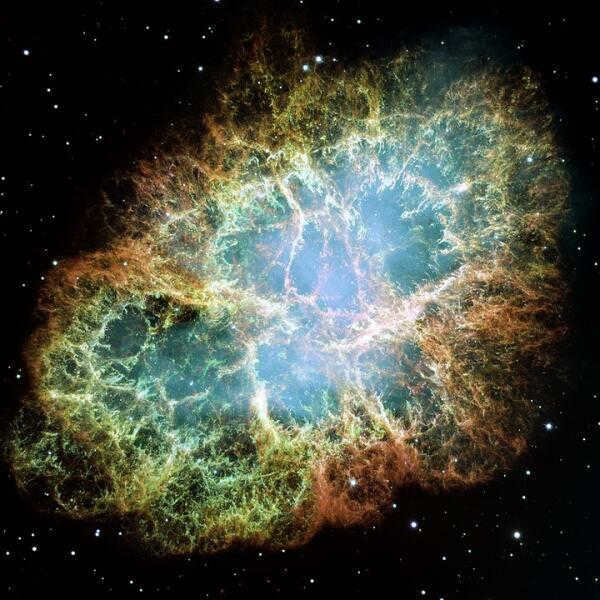
In the records of humanity, there are accounts of occurrences where a sudden appearance of a new star in the sky would astonish onlookers who would then lose sight of this “newborn” star after a period of 2-3 weeks. Information about seven such instances has been documented.
In the year 1604, a “new” star in the Serpens constellation was observed by numerous European astronomers, including Johannes Kepler. In 1680, a star in the Cassiopeia constellation experienced a eruption. Since then, no supernova explosions have been observed in our galaxy, the Milky Way.
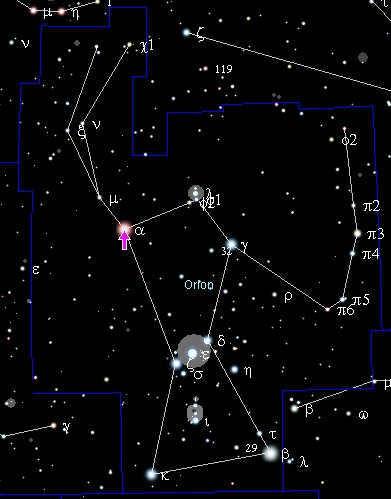
Nowadays, more than 60 supernova explosions in distant galaxies are observed annually by astronomers. One of the stars in close proximity to us that is in the process of becoming a supernova is Betelgeuse, located in the Orion constellation. This particular star is on the verge of undergoing a supernova event. It is positioned at a distance of 642.5 light-years from Earth, ensuring that its explosion will not pose any danger to us. However, it promises to be a truly captivating spectacle. Comparatively, the Crab Nebula, which was formed from a supernova explosion in 1054, was located at a distance ten times greater than Betelgeuse, indicating that the impact of Betelgeuse’s explosion will be significantly brighter.
What is a supernova explosion?
Stars undergo a continuous process of element synthesis, producing elements up to iron. Initially, they are composed mostly of hydrogen with a small amount of helium. As they evolve, the composition of stars changes, with approximately 75% hydrogen, 13-14% helium, and 1-2% heavier elements, including iron. Hydrogen and helium are found in the outer regions of the star, while the heavier elements are concentrated in the deeper layers.
Over millions of years, stars emit energy and undergo thermonuclear fusion reactions. Eventually, they deplete their hydrogen fuel and reach the end of their lives.
There are various possibilities for the fate of a star. Stars with a mass of 8-10 times that of the Sun experience a particularly intense phase of their evolution, known as a supernova explosion.
- Type I supernovae occur when there is a massive thermonuclear explosion.
- Type II supernovae occur when there is a gravitational collapse of the star.
A thermonuclear explosion supernovae happen in stars that have the minimum mass required for an explosion to take place. These stars are typically white dwarfs, which are made up of carbon and oxygen. When the core of the star reaches a certain size, fusion reactions of heavy elements start occurring from the center towards the surface.
Silicon is produced from carbon and oxygen under extreme pressures and temperatures, and a fusion reaction of two silicon nuclei produces a nickel nucleus – both of these fusion reactions release a tremendous amount of energy. Subsequently, nickel transforms into cobalt, and cobalt further transforms into iron – each fusion reaction accompanied by an enormous release of energy. The star’s matter rapidly heats up and explodes into the surrounding space. This is the event of a supernova explosion.
When a supernova occurs, it is due to a gravitational collapse. The star is sufficiently large that its gravitational pressure counteracts the fusion reactions of heavy elements. As long as the internal pressure can hold back the gravitational pressure, a massive dying star with a sizable iron core remains stable.
Eventually, the internal pressure is overcome by the gravitational force exerted by the newly formed heavy elements. This leads to the initiation of a gravitational collapse in the core, resulting in the transformation into a neutron star. The tremendous amount of energy that is released causes the outer layers of the previous massive star to be violently blown away into the surrounding space. At the heart of this explosive event, a compact neutron star is left behind, while the majority of the star’s mass is propelled in various directions with tremendous velocities.
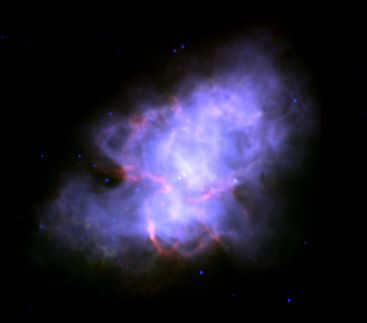
The Crab Nebula has a diameter of 6 light years and was created approximately 1000 years ago. It appears that the explosion had a velocity of up to 7000 km/sec.
What is the impact of supernovae on life on Earth?
The supernova explosion, which was recorded in Chinese and Japanese chronicles on June 4, 1054, had no adverse effects on life on Earth due to its significant distance from our planet. The nebula known as the Crab Nebula, discovered at the explosion site by British astronomer John Bevis in 1731, is the result of this explosion.
According to scientists’ calculations, if a supernova were to explode 50 light years away from our solar system, it would have severe consequences for all life on Earth. Similarly, if a star were to explode at a distance of 25 light years, it would result in the complete sterilization of life on the Earth’s surface.
- Firstly, the immense flood of radiation and high-energy particles would annihilate all life on the planet’s surface and in the oceans (although radiation would be less intense in deep depressions).
- Additionally, the radiation would obliterate the ozone layer that currently acts as a shield against solar radiation, making life on the surface impossible until the ozone layer is restored.
Fortunately, our position in the galaxy provides us with a certain level of safety. The Sun resides at the outermost edge of the galaxy, which means that we have relatively few neighboring stars in close proximity. While there are a couple of stars nearby that could potentially go supernova in a few million years, they will have moved significantly farther away from us by then. Therefore, it appears that we are not at risk of impending doom from this particular direction.
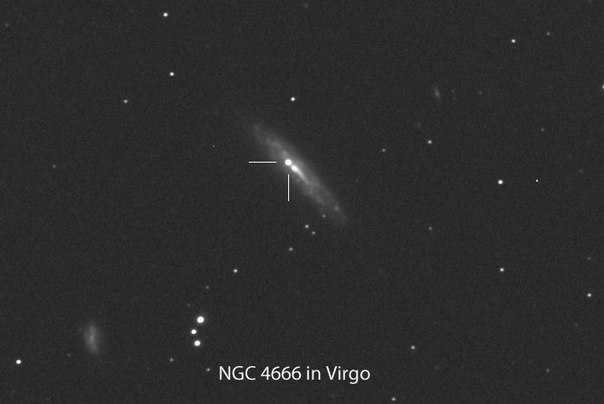
Type Ia supernovae serve as a striking illustration that a dormant white dwarf star is not as secure as we once believed.
Overview
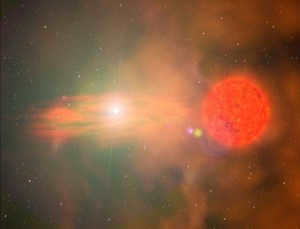
The process of Type Ia supernovae formation
Type Ia supernovae are celestial phenomena that occur when a white dwarf, a burnt-out star, undergoes a catastrophic explosion. Although this description simplifies the nature of a white dwarf, it is scientifically accurate. A white dwarf is essentially a star that has exhausted its nuclear fuel and ceased thermonuclear reactions. This fate awaits the majority of stars in the Universe, making the white dwarf the final stage of stellar evolution for a star with a mass similar to our Sun.
While a typical supernova arises from the detonation of a lone white dwarf as a result of the internal processes taking place within it, recent scientific hypotheses propose that Type Ia supernovae stem from the fusion of two white dwarfs. The occurrence of two white dwarfs in close proximity is relatively uncommon in the vast expanse of the cosmos. However, these celestial entities do exist within the Universe, primarily manifesting as remnants of binary star systems that are gravitationally linked to one another.
The process of the eruption
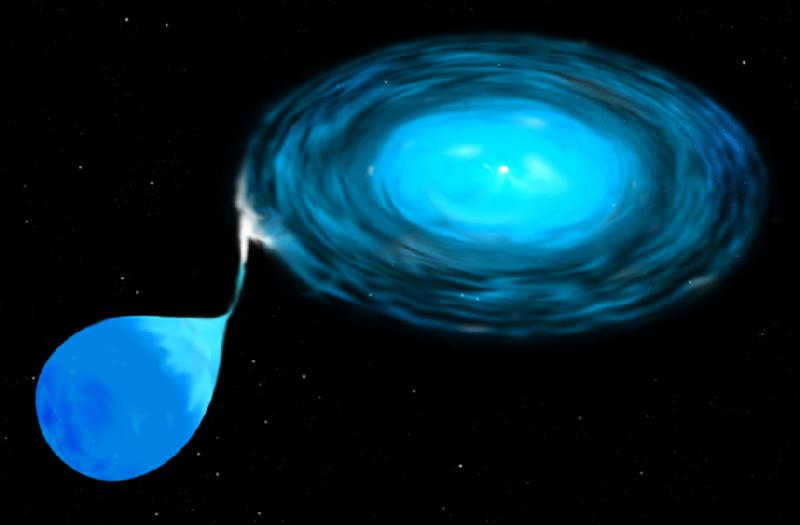
The accretion process occurs when a white dwarf and a normal star form a binary system, resulting in a Type Ia supernova explosion. These stars, held together by gravitational forces, gradually draw closer to each other. As the star’s material flows towards the white dwarf, its mass steadily increases. Once it surpasses the Chandrasekar threshold of 1.38 solar masses, the core temperature of the white dwarf rapidly rises until it reaches the ignition temperature of carbon.
A binary system composed of two white dwarfs
It should be noted that the occurrence of binary white dwarf systems in the vast expanse of space is a relatively uncommon phenomenon. Typically, only a handful of these systems are found among every thousand double star systems. The fusion of two white dwarfs leading up to a Type Ia supernova explosion is a lengthy process, spanning an average of 60 million years.
A duo of a brace of pale dwarfs in the planetary nebula Henize 2-428
Advantages of Type Ia supernovae
All Type Ia supernovae possess the identical mechanism for causing the outburst. Additionally, due to the uniformity of the mass of pale dwarfs, Type Ia supernovae possess the same maximum brightness. That is, if we take the brightness of two Type Ia supernovae at equidistant distances from the observer, their brightness will be identical.
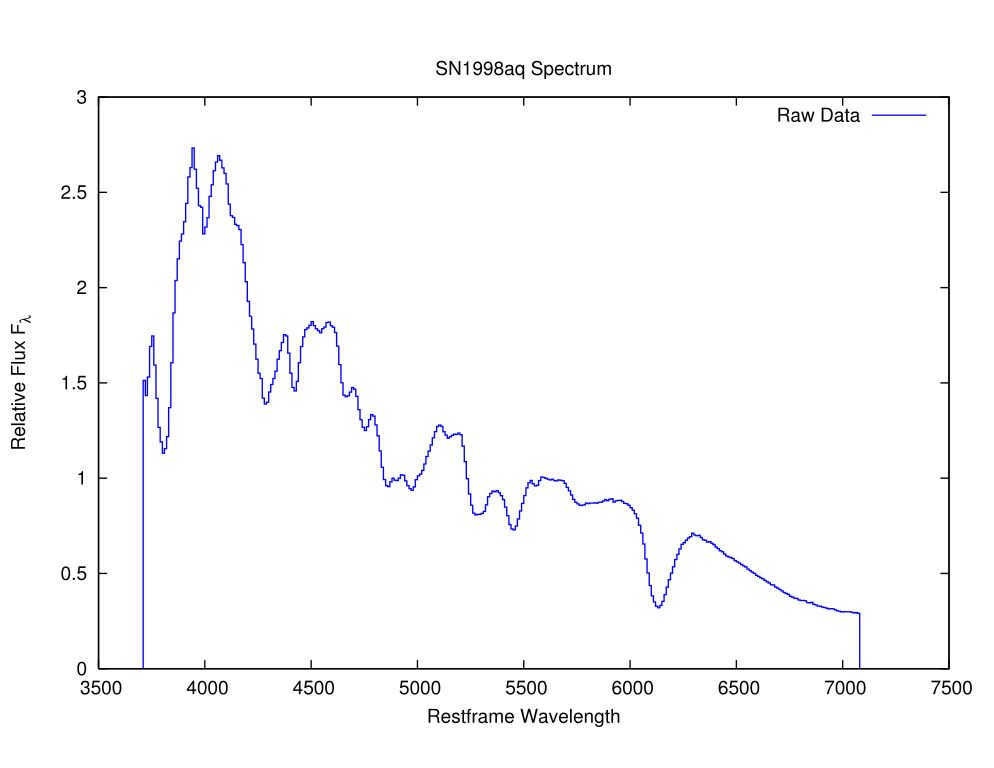
The spectrum of SN1998aq, a type Ia supernova, is shown here one day after reaching its maximum brightness.
Consequently, the brightness of a type Ia supernova that is closer to the observer will appear greater than that of a similar cosmic object that is farther away. However, the total amount of light emitted by the supernova remains constant. The only difference lies in the perceived magnitude of the star, which is subjective.
The modern astronomers find this fact incredibly fascinating. By measuring the apparent brightness of the supernova, they are able to calculate the distance from which the star erupted. Therefore, if a Type Ia supernova occurs in a different galaxy, scientists can determine not only the distance to the star, but also to the entire galaxy where it is located, based on the brightness of the supernova. This method of measuring distances in space is highly precise. Considering how challenging it is to determine distances even with advanced technology, we can conclude that Type Ia supernovae play a significant role in modern astronomy.
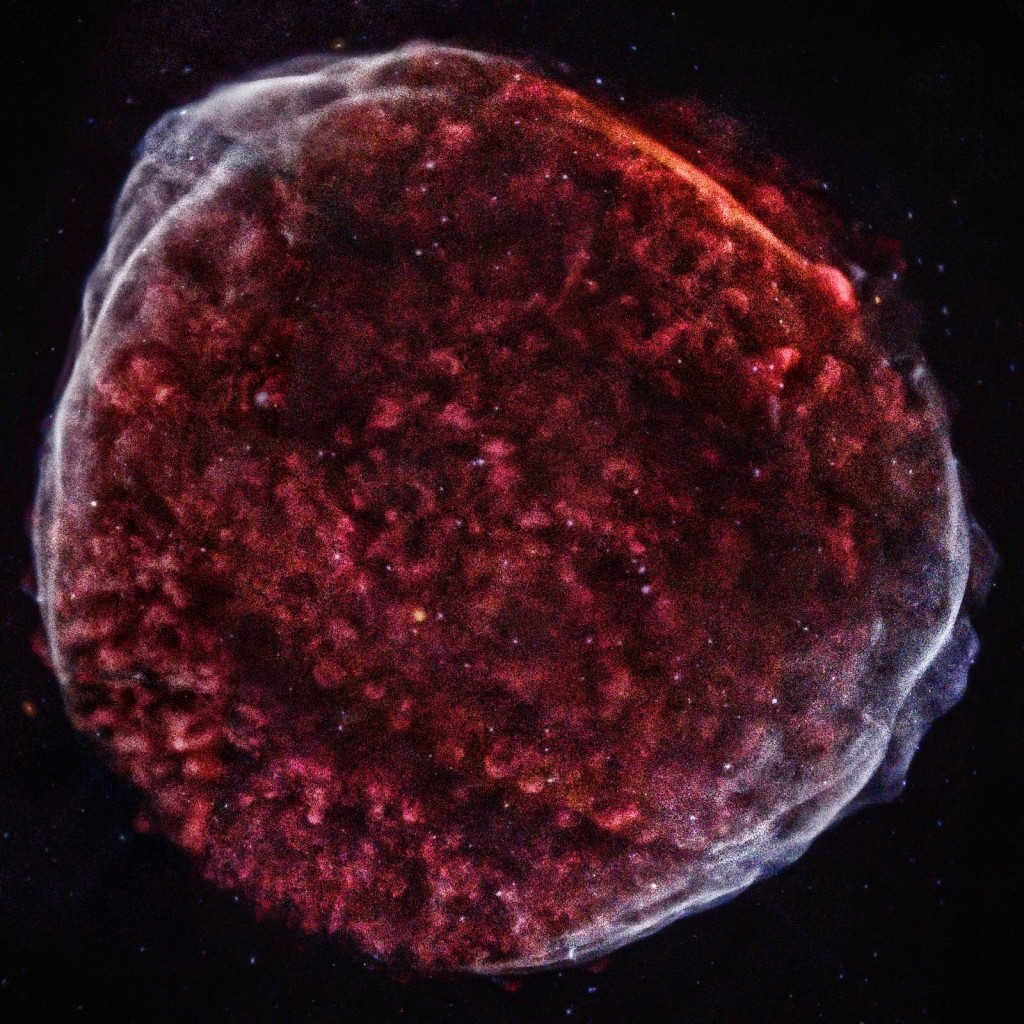
Type Ia supernova remnants are filled with fascinating details, just like any other celestial objects. As we previously discussed, these stars emit an astonishing amount of light, surpassing the Sun’s luminosity by a staggering 10,000 times. Additionally, it is worth noting that Type Ia supernovae are created through the fusion of white dwarf stars.
Resources related to the subject
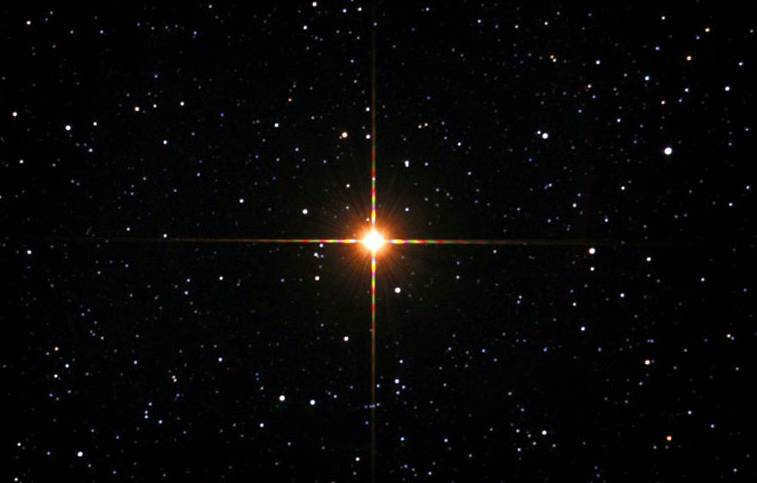
Moreover, it is common knowledge that when a Type Ia supernova explodes, it can give rise to a neutron star or a black hole. However, it is likely that you were not aware that Type Ia supernovae can also be the cause of extraordinary cosmic phenomena – pulsars.
Pulsars are immensely powerful sources of radio and gamma rays in the vast expanse of the Universe, rapidly rotating at astonishing speeds. The luminosity emitted by such celestial objects surpasses that of our very own Sun by several tens of thousands of times.

